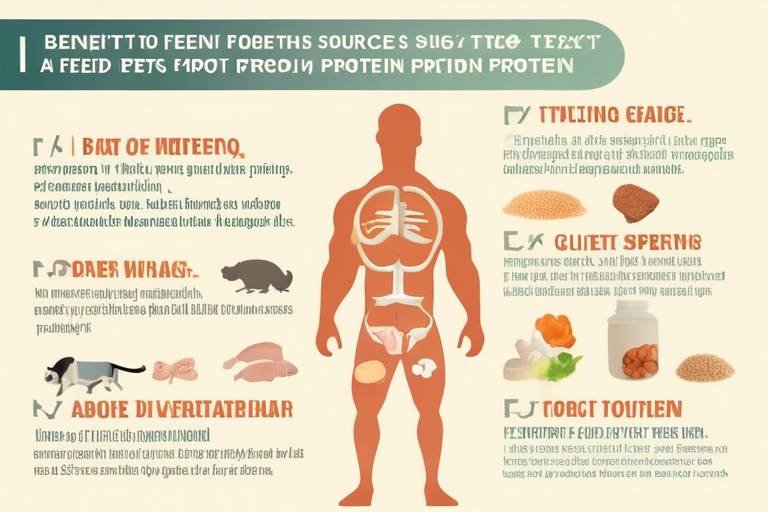The Benefits of Adding Fish to Your Pet's Diet
Are you looking for a way to boost your pet's health and happiness? Adding fish to their diet might just be the game changer you need! Fish is not only a delicious treat for your furry friend, but it also packs a powerful nutritional punch. Imagine your pet enjoying a meal that supports their overall well-being while tantalizing their taste buds. Sounds great, right? In this article, we will dive deep into the numerous advantages of incorporating fish into your pet's diet, including the nutritional benefits, improvements in health, and essential tips for safe feeding practices.
Fish is a treasure trove of essential nutrients that can significantly enhance your pet's health. Rich in essential fatty acids, high-quality proteins, and a variety of vitamins, fish can help your pet thrive. These nutrients play vital roles in maintaining optimal health, much like how a balanced diet helps us humans feel our best. For instance, the omega-3 fatty acids found in fish are renowned for their anti-inflammatory properties, which can benefit everything from skin health to heart function.
Moreover, fish is often easier to digest compared to other protein sources, making it an excellent option for pets with sensitive stomachs. When you consider the nutritional profile of fish, it’s clear that adding it to your pet’s diet can be a no-brainer. Here’s a quick overview of some key nutrients found in fish:
| Nutrient | Benefits |
|---|---|
| Omega-3 Fatty Acids | Supports skin and coat health, reduces inflammation |
| High-Quality Protein | Builds and repairs tissues, supports muscle health |
| Vitamins | Boosts immune function, supports overall health |
Does your pet have a dull coat or itchy skin? Adding fish to their diet might just be the solution! The omega-3 fatty acids found in fish can work wonders for your pet’s skin and coat. These healthy fats help maintain skin integrity, keeping it hydrated and reducing the risk of dry, flaky skin. Just like how we use moisturizer to keep our skin healthy, fish oil can provide your pet with the hydration they need from the inside out.
Fish isn’t just a tasty treat; it can also be a powerful ally in combating skin allergies and irritations. Many pets suffer from allergies that cause itching and discomfort, but the anti-inflammatory properties of fish oil can provide significant relief. It’s like having a soothing balm for your pet’s skin! If your pet struggles with common allergens, introducing fish into their diet could help alleviate some of their discomfort.
Now, not all fish are created equal! It’s essential to understand which types of fish are safe and beneficial for your pet. Some fish, like salmon and sardines, are packed with nutrients and are generally safe for pets. However, others, like certain types of freshwater fish, may contain harmful parasites or toxins. Always do your research or consult with your veterinarian to ensure you’re making the best choices for your pet’s health.
Preparation is key when it comes to feeding fish to your pet. You wouldn’t serve a raw meal to your family, right? The same goes for your pet! Proper cooking methods, such as baking or steaming, can help eliminate harmful bacteria while preserving the nutritional value of the fish. Additionally, be mindful of serving sizes; even the healthiest foods can lead to weight gain if given in excess. A good rule of thumb is to treat fish as a supplement to your pet's regular diet rather than a complete meal.
As our pets age, joint health becomes increasingly important. Fish oil has been linked to improved joint health in pets, particularly in older animals. The anti-inflammatory properties of fish oil can help reduce symptoms of arthritis and support mobility, allowing your furry friend to enjoy their golden years with ease. Think of it as a natural way to keep their joints lubricated and functioning smoothly!
If your pet has food sensitivities, fish can serve as a novel protein source that reduces the risk of allergic reactions. This is especially valuable for pets with specific dietary needs or those who have had trouble with more common protein sources like chicken or beef. By introducing fish gradually, you can help ensure that your pet adapts well to this new protein without any digestive upset.
When adding fish to your pet's diet, it’s vital to introduce it gradually. Just as you wouldn’t jump into a cold pool, your pet needs time to adjust to the new protein source. Start with small portions and monitor how your pet reacts. If they seem to enjoy it without any digestive issues, you can slowly increase the amount.
After incorporating fish into your pet's diet, keep a close eye on their health. Monitoring for any changes, whether positive or negative, can help you assess the benefits of this new addition. Are they more energetic? Is their coat shinier? Or are there any signs of digestive upset? Being proactive in observing your pet’s health will allow you to make necessary adjustments and ensure they’re thriving.
- Can all pets eat fish? - While most dogs and cats can enjoy fish, it’s essential to consult your veterinarian, especially if your pet has specific dietary restrictions.
- How often should I feed my pet fish? - Fish can be offered as a treat or supplement a couple of times a week, depending on your pet’s overall diet.
- Is raw fish safe for pets? - Raw fish can pose risks due to parasites and bacteria. It's best to cook fish before feeding it to your pet.

Nutritional Advantages of Fish
When it comes to enhancing your pet's diet, fish is a powerhouse of nutrients that can bring a myriad of health benefits. Packed with essential fatty acids, proteins, and vitamins, fish can significantly contribute to your furry friend's overall well-being. But what exactly makes fish such a nutritional gem? Let's dive deeper into the ocean of benefits it offers!
First off, fish is an excellent source of high-quality protein, which is crucial for your pet's growth and maintenance. Unlike some other protein sources that can be harder for pets to digest, fish is generally easier on their stomachs. This makes it a fantastic option for pets that may have sensitivities to more common proteins like chicken or beef. Additionally, the amino acids found in fish are essential for building and repairing tissues, making it a vital element in your pet's diet.
Moreover, fish is rich in omega-3 fatty acids, particularly EPA and DHA. These essential fatty acids are not just buzzwords; they play a significant role in promoting heart health, reducing inflammation, and supporting cognitive function. For pets, omega-3s can help maintain a healthy heart, reduce the risk of chronic diseases, and even improve brain function as they age. Just imagine your pet feeling spry and energetic, thanks to a diet enriched with these beneficial fats!
Let’s not forget about the vitamins and minerals that fish brings to the table. Fish is a great source of vitamin D, which is essential for calcium absorption and bone health. It also contains important minerals like selenium and iodine, which contribute to a healthy metabolism and immune system. In a nutshell, fish can be a one-stop-shop for many of the nutrients your pet needs to thrive.
To give you a clearer picture, here’s a quick comparison of the nutritional content of fish versus some other common protein sources:
| Protein Source | Protein (g per 100g) | Omega-3 Fatty Acids (g per 100g) | Vitamin D (IU per 100g) |
|---|---|---|---|
| Fish (Salmon) | 25 | 2.3 | 526 |
| Chicken | 31 | 0.1 | 0 |
| Beef | 26 | 0.1 | 0 |
As you can see from the table, fish not only provides a good amount of protein but also stands out when it comes to omega-3 fatty acids and vitamin D. This makes it a unique addition to your pet's diet that can help fill nutritional gaps that may be present with other protein sources.
In conclusion, incorporating fish into your pet's diet is not just a treat; it’s a way to ensure they receive a balanced and nutritious meal. With its rich profile of essential nutrients, fish can help enhance your pet's health, vitality, and longevity. So, why not explore the different types of fish available and see how they can make your pet's meals more exciting and beneficial? After all, a happy pet is a healthy pet!

Improved Skin and Coat Health
When it comes to your pet's appearance, a vibrant coat and healthy skin can speak volumes about their overall well-being. Adding fish to your pet's diet can significantly enhance their skin and coat health. You might be wondering, how exactly does this happen? Well, the secret lies in the rich content of Omega-3 fatty acids found in fish. These essential fatty acids are like the magic potion your pet needs to keep their skin hydrated and their coat shiny. Just imagine how a splash of fish can transform a dull, lifeless coat into a lustrous masterpiece!
Omega-3 fatty acids are known for their anti-inflammatory properties, which play a crucial role in maintaining skin integrity. This means that not only does fish help in keeping the skin moisturized, but it also aids in reducing inflammation that can lead to various skin issues. If your pet suffers from allergies or irritations, incorporating fish into their diet could be a game changer. Think of it as a soothing balm that calms the storm of skin discomfort, allowing your furry friend to feel at ease.
But wait, there's more! The benefits of fish extend beyond just a beautiful coat. Regular consumption can help alleviate symptoms of skin allergies and irritation. For instance, pets that are prone to itching or redness may find relief through the anti-inflammatory effects of fish oil. It's like giving your pet a gentle hug from the inside out, easing their discomfort and promoting a healthier skin barrier.
Now, you may be curious about which fish are best for your pet. Not all fish are created equal, and some types can be more beneficial than others. For instance, fatty fish like salmon and mackerel are packed with higher levels of Omega-3 fatty acids compared to leaner varieties. Here's a quick comparison:
| Type of Fish | Omega-3 Content (per 100g) | Benefits |
|---|---|---|
| Salmon | 2.5g | Rich in Omega-3s, supports skin health |
| Mackerel | 2.6g | High in Omega-3s, promotes a shiny coat |
| Tilapia | 0.9g | Lower in Omega-3s, suitable for variety |
So, when you’re considering adding fish to your pet's diet, opt for those with higher Omega-3 content for maximum benefits. However, always remember to prepare the fish properly to avoid any potential health risks. Cooking fish not only makes it easier for your pet to digest but also eliminates harmful bacteria that could cause illness.
In summary, incorporating fish into your pet's diet is an excellent way to improve their skin and coat health. With the right types of fish and proper preparation, you can give your furry friend the shiny coat and healthy skin they deserve. And who knows? You might even find that their newfound glow brings a smile to your face as well!
- Can all pets eat fish? - While most pets can safely consume fish, it's important to consult your veterinarian before introducing any new food into their diet.
- How often should I feed my pet fish? - Fish can be included in your pet's diet a few times a week as a supplement, but moderation is key.
- What types of fish should I avoid? - Avoid fish that are high in mercury, such as swordfish and shark, as they can be harmful to pets.
Reducing Allergies and Irritation
When it comes to our beloved pets, few things are as distressing as seeing them suffer from skin allergies and irritation. These issues can stem from various sources, including environmental allergens, food sensitivities, or even parasites. Fortunately, incorporating fish into your pet's diet can be a game-changer! The anti-inflammatory properties found in fish oil are not just a buzzword; they play a vital role in soothing irritated skin and alleviating discomfort. Imagine your pet, once constantly scratching and biting at their skin, now finding relief and comfort. It's a beautiful transformation!
Fish, particularly varieties rich in Omega-3 fatty acids, such as salmon and sardines, can help combat the inflammation that often leads to skin problems. These essential fatty acids are like nature’s magic potion, working to restore balance and health to your pet’s skin. When your pet consumes fish, these beneficial fats help to strengthen the skin’s barrier, making it less susceptible to irritants and allergens. The result? A happier, more comfortable pet!
But how exactly does this work? Well, Omega-3 fatty acids assist in reducing the production of certain inflammatory compounds in the body. This means that if your pet is prone to allergies, adding fish to their diet could help in reducing the severity and frequency of allergic reactions. It's like having a shield against the pesky irritants that can cause so much discomfort!
Moreover, the benefits of fish extend beyond just alleviating allergies. Many pet owners have reported noticeable improvements in their pet's overall skin health. For instance, if your dog or cat has been struggling with dry, flaky skin, fish can help restore moisture and shine. Their coat can become more vibrant and healthy, making them the envy of the neighborhood!
As you consider introducing fish into your pet's diet, it’s essential to be mindful of a few key points:
- Choose the right type of fish: Not all fish are suitable for pets. Stick to safe options like salmon, sardines, and mackerel, and avoid fish that are high in mercury, such as shark or swordfish.
- Consult your vet: Before making any significant dietary changes, it's always a good idea to consult with your veterinarian. They can provide tailored advice based on your pet's specific needs.
- Watch for reactions: As with any new food, monitor your pet for any adverse reactions when introducing fish to their diet. If you notice any signs of discomfort, consult your vet immediately.
In conclusion, adding fish to your pet's diet can be a powerful way to reduce allergies and irritation, ultimately leading to a happier, healthier companion. With the right approach and a bit of care, you can help your furry friend enjoy all the benefits that fish has to offer!
1. Can all pets eat fish?
Not all pets can safely consume fish. Always consult your veterinarian to determine if it's appropriate for your specific pet.
2. How often should I feed my pet fish?
Fish can be offered as an occasional treat or mixed into their regular diet. Moderation is key!
3. What types of fish are best for pets?
Salmon, sardines, and mackerel are excellent choices. Avoid fish with high mercury levels.
4. Can fish cause allergies in pets?
While fish can help reduce allergies, some pets may have sensitivities to fish itself. Monitor your pet closely when introducing it to their diet.
Choosing the Right Fish
When it comes to adding fish to your pet's diet, not all fish are created equal. It’s crucial to choose the right types of fish to ensure that your furry friend reaps the maximum health benefits without any risks. First and foremost, you should consider the source of the fish. Wild-caught fish are generally preferred over farmed varieties due to their higher levels of omega-3 fatty acids and lower levels of contaminants. However, this doesn’t mean that all farmed fish are bad; some can be raised in a sustainable and healthy manner.
Another important factor is the type of fish. Some fish are more beneficial than others, and some can even be harmful to pets. For example, fish like salmon, sardines, and mackerel are excellent choices due to their rich omega-3 content. On the other hand, fish such as tilapia or catfish may not provide the same nutritional benefits. Additionally, certain fish, like tuna, should be fed in moderation due to higher mercury levels. To help you make informed decisions, here’s a quick comparison:
| Fish Type | Nutritional Benefits | Considerations |
|---|---|---|
| Salmon | High in omega-3 fatty acids, protein | Ensure it is cooked to avoid parasites |
| Sardines | Rich in omega-3s and calcium | Can be fed whole, canned in water |
| Mackerel | Excellent source of fatty acids | Choose smaller species to avoid mercury |
| Tuna | High in protein | Feed in moderation due to mercury |
| Tilapia | Low in omega-3s | Not recommended as a primary fish source |
In addition to the type of fish, you should also consider how you prepare it. Cooking fish is essential to eliminate harmful bacteria and parasites that could harm your pet. Steaming or baking are great options; just make sure to avoid adding any seasoning or oils that could upset your pet's stomach. Serving fish in moderation is key, as too much can lead to imbalances in their diet.
Lastly, always observe your pet after introducing a new type of fish into their diet. Look for any signs of allergies or digestive issues, and consult your veterinarian if you have any concerns. By choosing the right fish and preparing it properly, you can significantly enhance your pet's diet and overall health.
- Can I feed my pet raw fish? It's generally safer to cook fish to eliminate the risk of parasites and bacteria.
- How often should I give fish to my pet? Fish can be served as an occasional treat or supplement, but should not replace their regular diet.
- What if my pet has allergies? Consult your veterinarian before introducing fish, especially if your pet has known food sensitivities.
- Is canned fish safe for pets? Yes, but make sure it's packed in water and free from added salt or spices.
Preparing Fish for Your Pet
When it comes to , ensuring safety and nutrition is paramount. Fish can be a delightful addition to your pet’s diet, but improper preparation can lead to health issues. First and foremost, always choose fresh fish from reputable sources. Look for fish that is free from additives and preservatives, as these can be harmful to your furry friend. Additionally, avoid fish that are high in mercury, such as shark or swordfish, as these can pose serious health risks.
Once you have selected the right type of fish, it's essential to prepare it correctly. Start by cleaning the fish thoroughly. Remove any scales and bones, as these can be choking hazards. Cooking the fish is highly recommended, as it eliminates harmful bacteria and parasites that could affect your pet's health. The best cooking methods are steaming, baking, or grilling without any seasoning. A simple, plain fish fillet is the healthiest option for your pet.
When serving fish, always ensure it's at a safe temperature—neither too hot nor too cold. Cut the fish into bite-sized pieces that are appropriate for your pet's size. For smaller pets, you might want to flake the fish to make it easier to eat. Remember, moderation is key! Fish should only be a supplement to your pet's main diet, not the entirety of it. A good rule of thumb is to offer fish once or twice a week, depending on your pet's dietary needs.
| Fish Type | Preparation Method | Notes |
|---|---|---|
| Salmon | Cooked (steamed or baked) | Rich in Omega-3 fatty acids |
| Sardines | Cooked (fresh or canned in water) | High in protein and low in mercury |
| Tilapia | Cooked (baked or grilled) | Good source of protein, low in fat |
| Tuna | Cooked (fresh only) | Limit consumption due to mercury content |
Lastly, always monitor your pet after introducing fish into their diet. Look for any signs of allergies or digestive issues, such as vomiting or diarrhea. If you notice anything unusual, consult your veterinarian immediately. By following these preparation tips, you can ensure that your pet enjoys the benefits of fish while staying safe and healthy.
Here are some common queries pet owners have regarding adding fish to their pets' diets:
- Can I feed my pet raw fish? It's best to cook fish to eliminate harmful bacteria and parasites.
- How often should I give my pet fish? Fish can be offered once or twice a week as a supplement to their regular diet.
- What types of fish should I avoid? Avoid high-mercury fish like shark and swordfish.
- Can fish help with my pet’s allergies? Yes, fish can have anti-inflammatory properties that may alleviate skin allergies.
Supporting Joint Health
When it comes to our furry friends, their mobility is paramount. Just like us, pets can experience joint discomfort as they age, and this is where the benefits of fish come into play. Fish oil, particularly rich in omega-3 fatty acids, has been shown to have remarkable anti-inflammatory properties that can significantly improve joint health in pets. Imagine your pet bounding around like a puppy again, free from the aches and pains that come with age! That's the kind of transformation we're talking about.
Research has indicated that fish oil can help reduce the symptoms of arthritis, a common ailment in older pets. By incorporating fish into their diet, you're not just feeding them; you're potentially enhancing their quality of life. Omega-3 fatty acids work by inhibiting the production of inflammatory compounds, which can lead to swelling and discomfort in the joints. This means that regular consumption of fish can help your pet maintain their mobility and enjoy their favorite activities, whether that's chasing after a ball or simply going for a leisurely stroll.
But how do you know if your pet is benefiting from this dietary change? It's essential to monitor their behavior and mobility closely. Look for signs of improvement, such as increased activity levels or a more playful demeanor. If your pet seems to be moving more freely and comfortably, it's likely that the fish in their diet is making a positive impact. Remember, though, that every pet is different. Some may respond more dramatically than others, so patience and observation are key.
Moreover, it’s important to choose the right type of fish. Not all fish provide the same level of omega-3 fatty acids. Fatty fish like salmon, mackerel, and sardines are excellent choices due to their high content of these beneficial fatty acids. However, it's crucial to avoid fish that may contain high levels of mercury or other toxins, which can be harmful to your pet. Always consult with your veterinarian to determine the best options for your furry friend, ensuring that their diet is both safe and beneficial.
In conclusion, adding fish to your pet's diet can be a game changer for their joint health. With the right choices and proper monitoring, you can help your pet lead a more active and pain-free life. Just think of it as giving them the gift of mobility and comfort—something every pet deserves!
- How often should I feed my pet fish? It's generally safe to include fish in your pet's diet a few times a week. However, consult your veterinarian for personalized recommendations.
- Can all pets eat fish? Most pets can eat fish, but some may have allergies or sensitivities. Always introduce new foods gradually and monitor for any adverse reactions.
- What types of fish are best for pets? Fatty fish like salmon, mackerel, and sardines are excellent choices due to their high omega-3 content. Avoid fish that may be high in mercury.
- Is it safe to feed my pet raw fish? While some pets can tolerate raw fish, cooking it can kill harmful bacteria and parasites, making it safer for your pet.

Fish as a Novel Protein Source
When it comes to feeding our furry friends, variety is not just the spice of life; it can be a game changer for their health. Fish serves as a fantastic alternative to traditional proteins like chicken or beef, especially for pets that may have developed sensitivities to these common ingredients. Just imagine your pet’s delight as they dive into a bowl of delicious fish, while you know you’re providing them with a nutrient-rich meal that supports their overall well-being.
One of the standout features of fish is its unique protein profile. Unlike more conventional meats, fish offers a novel protein source that can help reduce the risk of food allergies. This is particularly beneficial for pets that have experienced adverse reactions to more commonly used proteins. By introducing fish into their diet, you can potentially sidestep the itchy, uncomfortable symptoms that often accompany food sensitivities.
Furthermore, fish is not just any protein; it’s packed with essential amino acids that are crucial for your pet's muscle development and overall health. The high digestibility of fish means that your pet can absorb these nutrients more efficiently, leading to better health outcomes. Think of it as a high-performance fuel for your pet's body, enabling them to run, play, and enjoy life to the fullest.
However, it’s important to choose the right kind of fish. Not all fish are created equal, and some can contain high levels of mercury or other toxins. Opt for wild-caught fish whenever possible, as they typically have lower contaminant levels than farmed varieties. Fish like salmon, sardines, and mackerel are excellent choices that not only provide protein but are also rich in omega-3 fatty acids, further enhancing their health benefits.
To make the transition easier for your pet, consider introducing fish gradually. Start by mixing small amounts of cooked fish with their regular food, allowing their digestive system to adjust. This gradual approach can help prevent any potential gastrointestinal upset. Monitor your pet closely during this transition, watching for any signs of allergies or intolerance, such as changes in their coat condition, energy levels, or digestive health.
In conclusion, incorporating fish into your pet's diet as a novel protein source can be a wise choice, especially for those with specific dietary needs. Not only does it provide a unique flavor that many pets love, but it also offers numerous health benefits that can enhance their quality of life. So why not give it a try? Your pet might just thank you with a wagging tail or a playful pounce!
- Is fish safe for all pets? While fish is generally safe for most pets, it's important to consult your veterinarian, especially if your pet has underlying health conditions.
- How often can I feed my pet fish? Fish can be included in your pet's diet a few times a week, but moderation is key to ensure a balanced diet.
- What types of fish should I avoid? Avoid feeding pets fish that are high in mercury, such as shark or swordfish. Stick to safer options like salmon and sardines.
Introducing Fish Gradually
When it comes to introducing fish into your pet's diet, patience is key. Just like us, pets can have sensitive stomachs, and a sudden change in their diet can lead to digestive issues. Think of it as introducing a new friend to your pet; you wouldn't throw them into the deep end right away, would you? Instead, you’d let them get acquainted slowly. The same principle applies here. Start by offering a small amount of cooked fish mixed with their regular food. This gradual introduction allows your pet's digestive system to adapt and helps you monitor for any adverse reactions.
Begin by replacing a small portion of their usual protein with fish. For example, if your pet usually eats 1 cup of chicken, try substituting 1/4 cup of that with cooked fish. Observe how your pet reacts over the next few days. If they seem to enjoy it and show no signs of discomfort, you can gradually increase the amount of fish in their diet. However, if you notice any signs of digestive upset—like vomiting or diarrhea—it's best to reduce the fish back to the initial amount and try again later.
Here’s a simple breakdown of how you can introduce fish to your pet’s diet:
- Week 1: Mix 1/4 cup of cooked fish with their regular food.
- Week 2: Increase to 1/2 cup if all goes well.
- Week 3: Assess your pet's health and comfort levels. If everything is fine, you can continue to increase the portion.
Make sure to choose fish that is safe for pets, such as salmon or sardines, and always cook it thoroughly to eliminate any harmful bacteria. Avoid seasoning, as many spices can be harmful to pets. Remember, the goal is to enhance their diet, not to overwhelm their system. By taking it slow, you can ensure that your pet enjoys the benefits of fish without any hiccups along the way.
Q: How much fish can I safely feed my pet?
A: It’s generally safe to feed your pet fish a few times a week, but the portion size should depend on their overall diet and health. Always consult your vet for personalized advice.
Q: Can all pets eat fish?
A: Most pets can eat certain types of fish, but it’s important to avoid fish high in mercury, like shark or swordfish. Always check with your vet if you're unsure.
Q: What are the signs my pet is having a negative reaction to fish?
A: Look out for symptoms such as vomiting, diarrhea, or unusual lethargy. If any of these occur, stop feeding fish and consult your vet.
Q: Should I feed my pet raw fish?
A: Raw fish can pose health risks due to parasites and bacteria. It's best to cook fish thoroughly before serving it to your pet.
Monitoring Your Pet's Health
Once you've introduced fish into your pet's diet, it's crucial to monitor their health closely. Just like humans, pets can react differently to new foods, and being vigilant can help you catch any potential issues early. Start by observing your pet's behavior and physical condition. Are they more energetic? Is their coat looking shinier? These are positive signs that the fish is benefiting them. However, if you notice any changes such as vomiting, diarrhea, or excessive scratching, it’s important to take note.
One effective way to track your pet's health is to maintain a health journal. Documenting their meals, any changes in behavior, and physical appearance can provide valuable insights. You can create a simple table to help organize your observations:
| Date | Food Given | Behavior Observed | Physical Changes |
|---|---|---|---|
| MM/DD/YYYY | Fish (type) | Energetic/Playful | Shinier coat/No changes |
| MM/DD/YYYY | Fish (type) | Less active | Scratching/Redness |
Additionally, it's a good idea to schedule regular check-ups with your veterinarian. They can provide professional insights and help you determine if the fish is positively impacting your pet's health. They might even suggest specific blood tests or allergy tests to ensure that your pet is responding well to the dietary change. Remember, your veterinarian is your best ally in ensuring your pet thrives on their new diet.
Lastly, don't forget to engage your pet in regular activity. Exercise plays a vital role in their overall health and can help you gauge how well they're adjusting to their new diet. If your pet seems more lively and is maintaining a healthy weight, it’s a good indication that the fish is serving them well. However, if they start to gain or lose weight unexpectedly, it could be a sign to reassess their diet. Keeping a close eye on their health after introducing fish will not only ensure their well-being but also deepen the bond you share with your furry friend.
- Can all pets eat fish? - While most pets can benefit from fish, it's important to consult with your veterinarian before introducing it to ensure it's suitable for your specific pet.
- How often should I feed my pet fish? - Fish can be offered as a part of a balanced diet, typically 2-3 times a week, but this can vary based on your pet's needs.
- What types of fish are best for pets? - Safe options include salmon, sardines, and mackerel. Avoid fish with high mercury levels, such as swordfish or shark.
- Should I cook the fish before feeding it to my pet? - Yes, cooking fish helps eliminate harmful bacteria and parasites. Always remove bones to prevent choking hazards.
Frequently Asked Questions
- What are the nutritional benefits of adding fish to my pet's diet?
Fish is packed with essential fatty acids, high-quality proteins, and vital vitamins that can significantly enhance your pet's overall health. Omega-3 fatty acids, in particular, are known for their anti-inflammatory properties and can support skin, coat, and joint health.
- How does fish improve my pet's skin and coat health?
The omega-3 fatty acids found in fish can help maintain skin integrity and promote a shiny coat. These nutrients can also help reduce allergies and irritation, making your pet feel more comfortable in their own skin.
- Can fish help with my pet's allergies?
Absolutely! Fish has anti-inflammatory properties that can alleviate skin allergies and irritation. By incorporating fish oil into your pet's diet, you may notice a reduction in itching and discomfort caused by common allergens.
- Which types of fish are safe for my pet?
Not all fish are suitable for pets. It's important to choose fish that are low in mercury and safe for consumption, such as salmon, sardines, and herring. Always consult your veterinarian for specific recommendations based on your pet's dietary needs.
- How should I prepare fish for my pet?
When preparing fish for your pet, it's crucial to cook it thoroughly to eliminate harmful bacteria. Baking or steaming are great options. Avoid adding any seasoning or sauces, as these can be harmful to your pet.
- Can fish help support my pet's joint health?
Yes! Fish oil is known to improve joint health and can be particularly beneficial for older pets suffering from arthritis. The anti-inflammatory properties can help reduce pain and improve mobility.
- How can I introduce fish into my pet's diet?
It's best to introduce fish gradually to prevent any digestive upset. Start with small amounts and monitor your pet's reaction before increasing the serving size. This way, your pet can adjust to the new protein source without any discomfort.
- What should I monitor after adding fish to my pet's diet?
After introducing fish, keep an eye on your pet's health. Look for any changes in their coat, skin, or overall behavior. Monitoring these aspects can help you determine the positive effects of fish and make necessary adjustments to their diet.



















